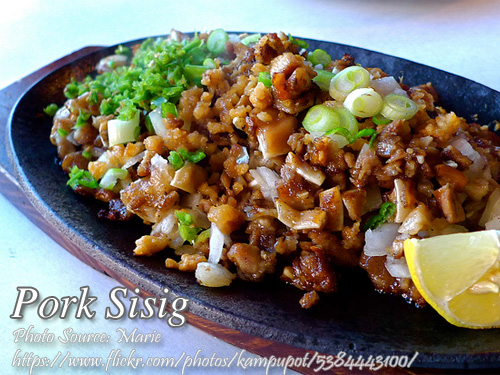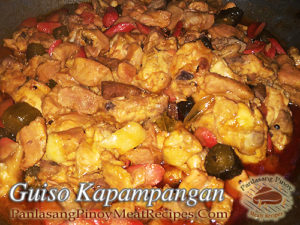One of the most favorite Filipino recipe is the pork sisig recipe made from chopped grilled pork jowl or pork cheeks. Since this dish is so popular, it is served in most Filipino restaurants, fastfoods and foodcarts. It is also a popular pulutan, paired with beer for those who love social drinking. The recipe I have here is a sizzling sisig and it is close to the authentic Kapampangan style pork sisig because it does not have mayonnaise and other flavor enhances such as Knorr seasoning.
If you want it to become more presentable and appetizing, you can put it in a sizzling plate and garnish it with raw egg on top. When buying pig’s jowl, it is not necessary to include the whole head. You can ask the meat vendor to give you the cheek or jowl part of the pig’s head. This part is very suitable in making sisig unlike the pork belly. The only downside is it is very fatty and there are almost no lean meat in pork cheeks or jowl.
Pork Sisig: A Sizzling Filipino Favorite
When I think of pork sisig, I can’t help but be transported back to my childhood visits to Pampanga, the culinary capital of the Philippines. My uncle, Tito Nestor, was a master of this iconic dish. He always said that a good pork sisig starts with the right cut of meat—pork jowl or cheeks—and the patience to bring out its unique flavors. This sizzling pork dish has not only become a staple at family gatherings but also holds a special place in my heart as one of the ultimate comfort foods.
What is Pork Sisig?
Its is a classic Filipino dish known for its bold flavors and crispy, smoky texture. Originating in Pampanga, it’s traditionally made with chopped grilled pork jowl, chicken liver, onions, and calamansi juice. It’s often served on a sizzling plate, topped with a raw egg that cooks from the heat of the dish. Sisig is beloved across the Philippines, often enjoyed as a main dish or as pulutan, a companion to cold beer during lively get-togethers.
Unlike the modernized versions you might find in some restaurants, which add mayonnaise or other seasonings for creaminess, this recipe sticks close to its Kapampangan roots. It’s all about the natural richness of the pork, the tangy bite of calamansi, and the slight heat from chilies.
Preparing the Perfect Pork Jowl for Sisig
The star of the dish is undoubtedly the pork jowl, also called pork cheeks. This cut of meat is prized for its fatty layers and gelatinous texture, which give sisig its distinctive character. When my cousin Mayet first introduced me to cooking sisig, she emphasized the importance of thoroughly cleaning the pork jowl. Washing it under running water and letting it drain ensures that no impurities mar the final dish.
Once clean, the pork jowl is boiled until tender. This step not only softens the meat but also allows some of the excess fat to render out, creating a lighter, crispier final product. After boiling, the jowl is broiled or grilled to develop a smoky flavor and crisp texture. If you’re short on time or prefer a modern approach, an air fryer works wonders for this step while still achieving the signature char.
Why Chicken Liver is Essential
Some people shy away from using chicken liver in their sisig, but I believe it’s a non-negotiable ingredient. The liver adds a depth of flavor—a slightly earthy and creamy undertone that balances the richness of the pork. Seasoning the liver with salt and pepper before grilling enhances its taste, and when chopped finely and mixed into the dish, it creates a harmony of flavors. My Lola often said that the secret to great sisig was the perfect ratio of liver to pork, and I couldn’t agree more.
Mixing It All Together
Combining the ingredients is where the magic happens. Tossing together the finely chopped grilled pork jowl, chicken liver, onions, green chilies, and calamansi juice creates an explosion of flavors and textures. The calamansi provides a tangy brightness that cuts through the richness of the pork, while the onions and chilies add a crunchy, spicy kick.
Tito Nestor had a trick for ensuring every bite was packed with flavor—he’d let the mixture sit for a few minutes before transferring it to the sizzling plate. This allowed the calamansi juice and spices to seep into the meat, enhancing its taste even more.
Serving Sizzling Pork Sisig
No sisig is complete without a sizzling plate. Heating the plate over the stove and melting a generous pat of butter before adding the pork mixture not only keeps the dish hot but also adds an irresistible nutty flavor. My siblings and I would hover around the kitchen, waiting for the moment when Tito Nestor would bring the sizzling plate to the table, garnished with a sprinkling of chopped red chilies. The aroma was enough to make anyone’s mouth water.
For an authentic presentation, crack a raw egg over the hot sisig just before serving. Mix it in quickly, and the heat from the dish will cook the egg, adding a silky finish. Pair it with steaming white rice for a truly satisfying meal.
The Origins of Pork Sisig
Pork sisig has a rich history that traces back to Pampanga in the 17th century. Originally, the term “sisig” referred to a method of preserving meat and vegetables by marinating them in vinegar or calamansi juice. Over time, the dish evolved into the sizzling masterpiece we know today, thanks to Aling Lucing Cunanan, who popularized the modern version in the 1970s. Her ingenuity in grilling and chopping pork jowl revolutionized the way Filipinos enjoyed this dish.
Food for Thought
Pork sisig is more than just food—it’s a celebration of resourcefulness and creativity. Using parts of the pig that might otherwise be discarded, like the jowl and liver, highlights the Filipino tradition of making the most out of every ingredient. It’s a dish that brings people together, whether as pulutan during lively celebrations or as a comforting meal on a quiet evening.
So, the next time you’re craving a hearty, flavorful dish, give it a try. It’s a labor of love, but every bite is worth it. Just ask my family—there’s never any left when sisig is on the table!
Sizzling Pork Sisig (Pork Jowl)
Ingredients
- 1 kilo pork cheek or pork jowl
- 1/4 kilo chicken livers
- 1 tsp. black pepper corns
- 3 pcs bay leaves
- 1/4 tsp. black pepper powder
- 1/2 tsp. salt
- 1 to 2 pieces white onion chopped
- 1/3 cup calamansi juice or lemon juice
- 1 tsp. ground black pepper
- 1 Tbsp. salt or to taste
- 1 pc long green chili sliced diagonally
- 1 Tbsp. butter or margarine per sizzling plate
- siling labuyo soy sauce and calamansi for condiments
Instructions
How To Cook Sizzling Pork Sisig Using Pork Jowl
- Wash pork jowl or pork cheeks in running water. Put in a colander to drain excess water.
- Boil the pork jowl until tender for about 45 minutes. Remove from pot and drain in a colander.
- Wash chicken liver and drain. Put in a bowl and season with salt and pepper.
- Broil pork jowl and chicken liver then cut into small pieces. You can use an airfryer if you don't want to broil it in a charcoal grill.
- Prepare a mixing bowl and combine pork jowl, chicken liver, onions, green chili, salt, black pepper and calamansi juice. Toss until well combined.
- Heat sizzling plate on a stove and melt butter. Put the pork sisig and stir gently for a few minutes.
- Garnish with red chili peppers and serve with steaming rice!
Video
Notes
Cooking Tips:
Choose the Right Cut of Pork
For authentic sisig, use pork jowl or cheeks for their rich, fatty texture and deep flavor. These cuts crisp up beautifully when grilled or broiled, giving the dish its signature crunch. Avoid leaner cuts like pork belly, as they lack the gelatinous quality that makes sisig truly indulgent.Grill for Smoky Goodness
Grilling the pork jowl over charcoal enhances the smoky, savory flavor of the meat. If grilling isn’t an option, an air fryer can achieve a similar crisp texture, but a grill delivers that unmatched char. The smoky aroma is one of the key characteristics that sets this pork dish apart from other dishes.Balance Flavors with Calamansi
Calamansi juice is the perfect tangy contrast to the richness of the pork and liver in sisig. Add just the right amount to avoid overpowering the other flavors—start small and adjust to your taste. This touch of acidity cuts through the fat and brightens the overall flavor profile of the dish.






Thanks for this easy to cook pork sisig recipe!
Hi Fely, Thanks for visiting this blog!